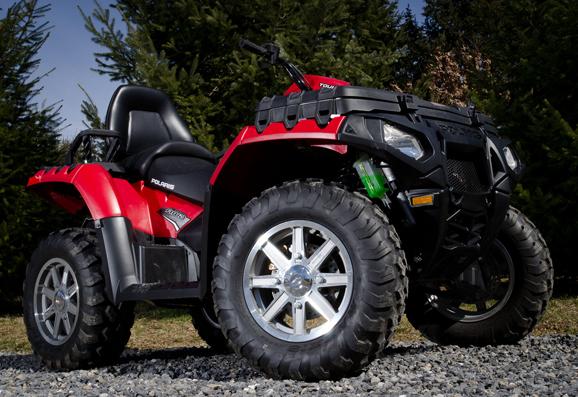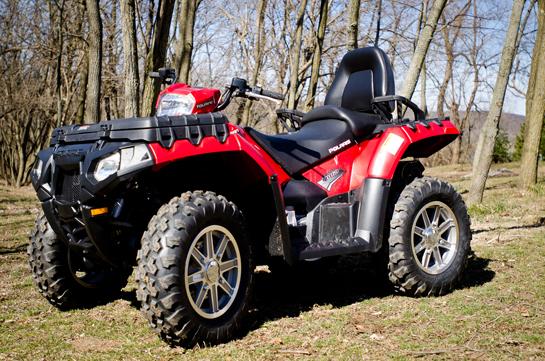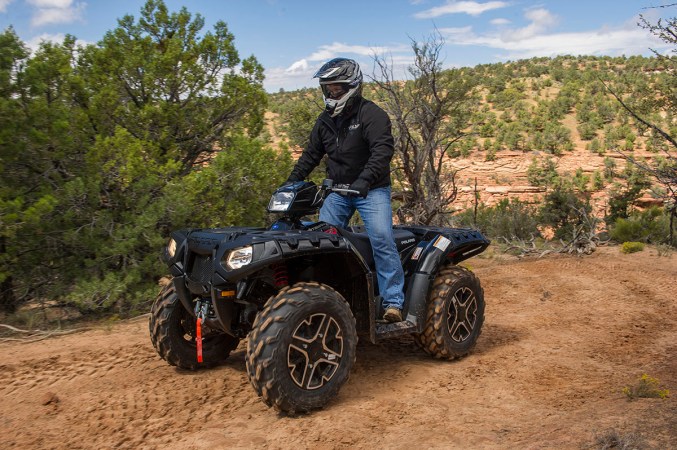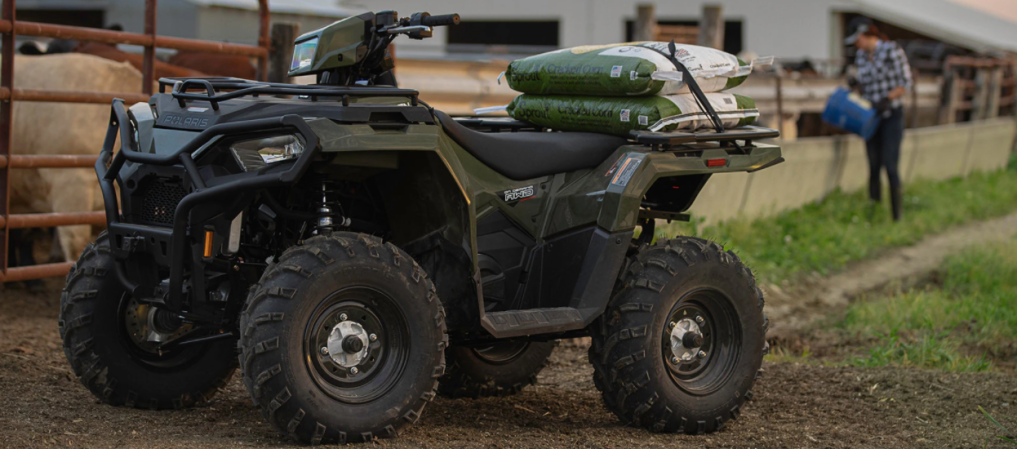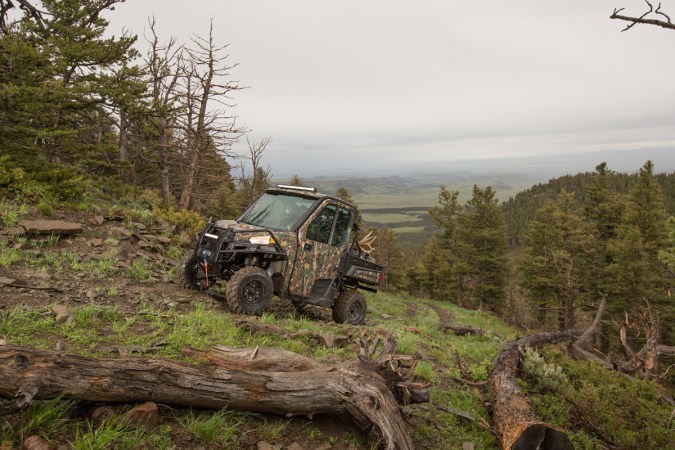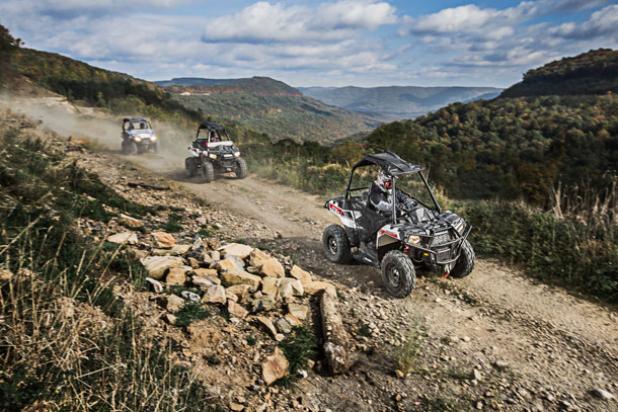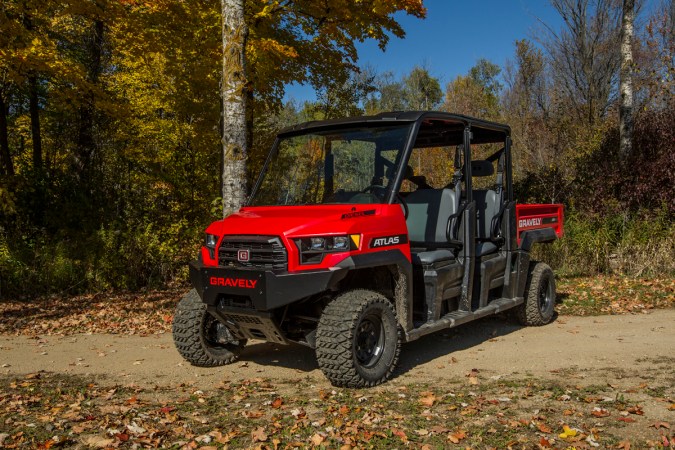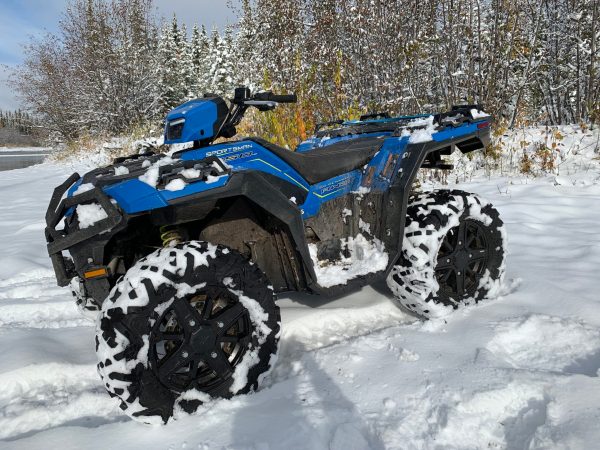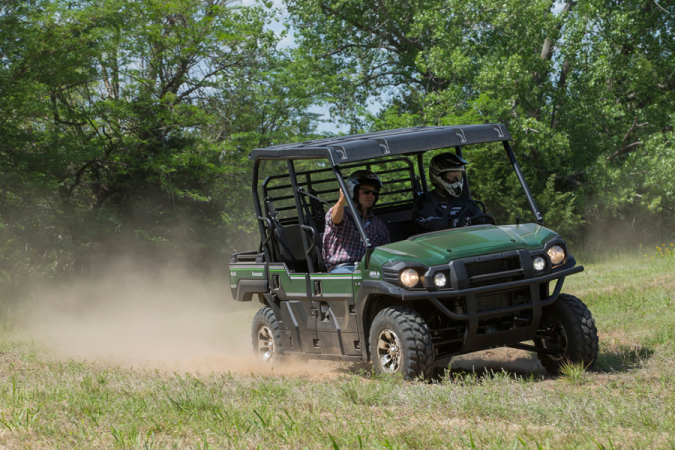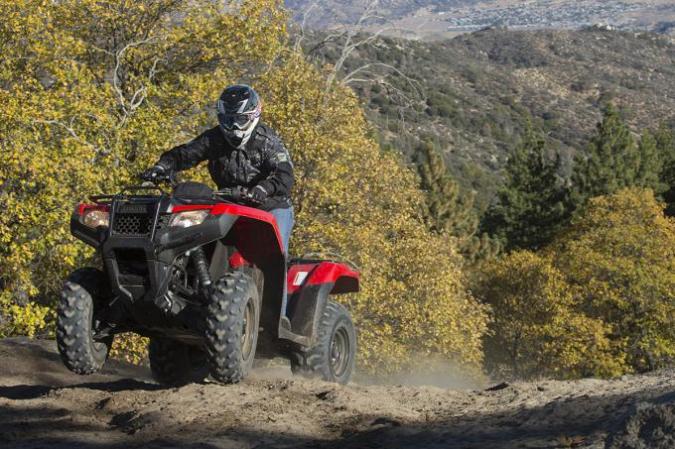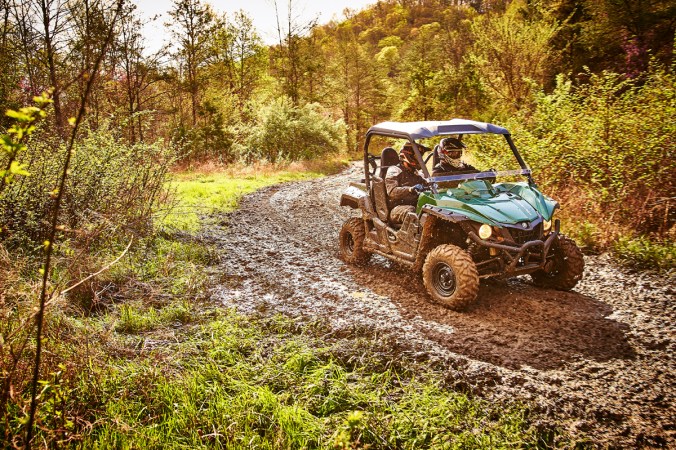We may earn revenue from the products available on this page and participate in affiliate programs. Learn More ›
A company that proclaims its ATV as the “Hardest Working. Smoothest Riding” better have a product that can back that claim up. When Polaris redesigned its current big-bore Sportsman line a few years ago, the replacement was a much- needed improvement over the previous generation. Polaris is a thriving American brand that has continually evolved, introduced new models that redefine market segments, and developed a reputation for thinking outside the box. Now Polaris is reinventing itself in an economic climate where survival is the primary goal. In 2012, Polaris returns to the 2-Up market they helped create with a more muscular and refined Sportsman Touring 850 H.O.
During testing, I logged approximately 100 miles aboard my demo Sportsman Touring 850 H.O., zipping down tight trails, wallowing through murky mud holes, bouncing over jagged blast rock, and hauling just about anybody I could talk into hopping on the rear Comfort Ride passenger seat. My thoughts? The 2012 Sportsman 850 H.O. has muscle, finesse, capability to conquer the harshest terrain, and the smoothest ride in the 2-Up class.
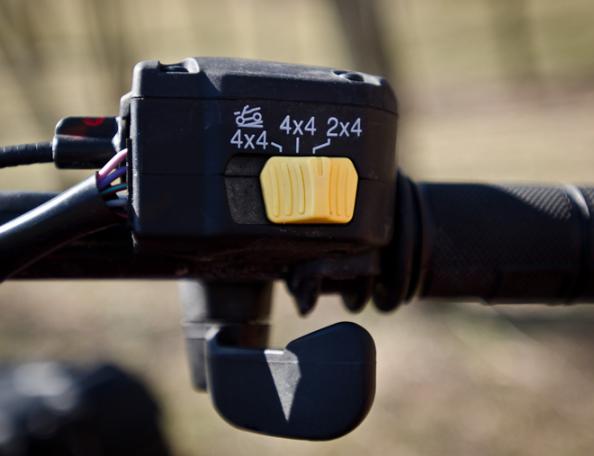
Engine/Transmission/Drivetrain
Key Features
– Increased Performance: With a revised airbox and throttle body, the Touring 850 H.O. gets a 20 percent increase in off-the-line acceleration, making it more responsive to help compensate for the added girth of this nearly 800-pound machine.
– Active Descent Control (ADC): Below 15mph, the front wheels are locked to the rears to help maintain control on downhill plunges, making the ride safer in slippery situations.
– Engine Braking System (EBS): Constantly Variable Transmissions (CVT’s) are coupled to the engine only when a clutch is engaged, which is typically under throttle. To provide deceleration that mimics natural engine braking while coasting, EBS handles this task.
– On-Demand True All-Wheel Drive (AWD): When selected, both front wheels engage when rear wheel slippage is detected, keeping steering effort light by only engaging the front drivetrain when absolutely necessary.
Performance
Despite the extra weight and additional length of the Touring model, the crisp throttle response on this passenger-friendly ATV still delivers a sporty, fun demeanor. The Engine Braking System (EBS) performed impressively as I took it down steep winding trails and felt very natural, like the engine was actually doing the compression braking itself rather than relying on electronics and clutching.
Polaris’ On-Demand True All Wheel Drive (AWD) operates a little differently than the typical four-wheel drive system used by the rest of the industry. Rather than the front and rear drivetrain being locked together permanently via a locked clutch when 4×4 is engaged, the Polaris system monitors the difference between the speed of the front and rear wheels and transfers power to both front wheels only when rear slippage is detected. Even when the AWD button is engaged on the Polaris, power is only transferred to the front wheels if the system detects the rear wheels slipping. The capability of On-Demand True AWD in a gooey mud hole is remarkable. When the system engages, both front wheels pull equally like an automatically locking front differential. The downside to a locked differential is a massive increase in steering effort when traction is regained. The beauty of Polaris’ system is as soon as traction returns, both front wheels are disengaged automatically, providing a very light steering feel. Paired with the Electronic Power Steering (EPS) on my Touring demo, the engagement of the AWD was almost imperceptible in my tests, even with all four wheels clawing for traction.
Coasting down a slippery incline, the Polaris AWD system isn’t designed to engage the front wheels because wheel slippage isn’t detected under throttle. This is the exact reason Active Descent Control (ADC) was developed. With the ADC switch engaged at speeds less than 15 mph, the front wheel drive system locks the front drivetrain to provide the same all wheel compression braking a typical four wheel drive system naturally possesses. The ADC does work nicely, but since it’s a separate setting on the AWD switch, it was just another thing I had to think about instead of scanning the trail.
Hits
– Impressive 850cc V-twin engine that returns with even more power
– Capable On-Demand All Wheel Drive (AWD)
– Engine Braking System (EBS) feels so natural, it’s nearly imperceptible
Misses
– Fuel injection doesn’t feel as refined as competitors and sometimes idles roughly
– The big V-twin vibration is noticeable.
– Active Descent Control (ADC) can be intrusive in very technical crawling situations and requires being switched on/off.
_**
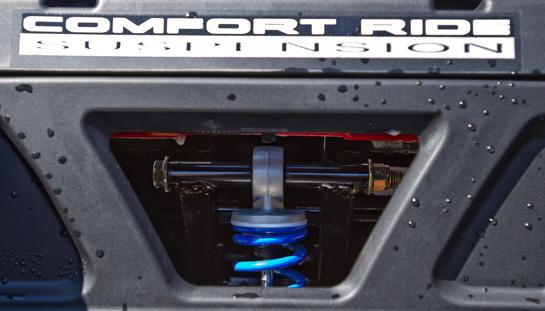
**
Chassis/Suspension
_Key Features:
– Smoothest Riding: Polaris’ slogan is, “Hardest working. Smoothest riding”. I agree with the latter 100 percent.
– Electric Power Steering (EPS): Polaris provides the most power steering assist in the industry, a full 30 percent more than the competition. This allows the ATV to be ridden harder with less fatigue.
– 12″ of ground clearance: enables the Sportsman to drive over obstacles rather than into them.
Performance
In my opinion, the Polaris Sportsman Touring gives the most comfortable ride in the 2-Up market. With full four-wheel independent suspension, the chassis’ ability to absorb impacts from the gnarliest rocks, ruts, logs, and stumps is downright impressive. Front suspension travel is a full 9 inches, while the rear boasts 10.25 inches. The stock seat is ultra-plush, which also helps deliver that smooth ride you hear about in the Polaris commercials.
Polaris’ Electric Power Steering (EPS) system functions even if the engine isn’t running. Sitting in the saddle with the ignition off, the 798-pound dry weight makes the handlebars difficult to turn. By simply turning the ignition key to the “on” setting, I was able to turn those same bars with my pinky finger. This demonstration alone is enough to convince naysayers of the EPS’s legitimacy. On the trail the EPS performs well, but doesn’t feel as transparent as the same EPS system on the standard Sportsman. The reason is likely due to being calibrated to compensate for the extra weight of a passenger, and the added girth of the Touring model.
Hits
Super-plush ride
Long front and rear suspension travel
Power steering works even when the Touring 850 HO isn’t in motion
Misses
At 798lbs, this ATV is very heavy
EPS doesn’t feel as refined on the trail as the standard Sportsman 850 EPS.
**
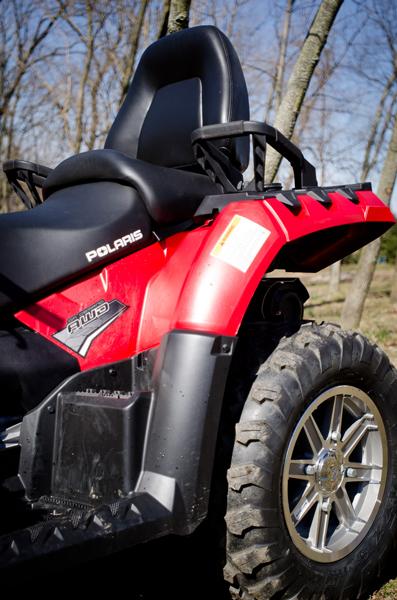
****Ergonomics****_
Key Features_**
Plush Seat: The most comfortable seat in the industry, allowing longer rides with less fatigue.
– Narrow Center Section: Wide floorboards and a narrower chassis in the vicinity of the knees and ankles. This gives the rider a more natural and comfortable seating position.
– Single Lever Braking: Provides stopping power to all four wheels with one lever, eliminating the need for a separate front brake handle. Unfortunately, this deletes the ability to apply only the front brakes.
Performance
In the saddle, the bars and controls are easily reachable and intuitively placed and the seat is very comfortable. All Polaris utility ATV’s have single lever braking that stop all four wheels simultaneously, and a rear foot brake located on the right floorboard. The single lever brake system stops the Touring effectively, but I prefer separate front and rear brakes for very technical terrain. The floorboard mounted rear brake pedal is located a bit too high, making it difficult to reach with a stiff riding boot.
The Touring 850 HO model is much narrower through the center and floorboard area than previous generation Polaris’, which made it more comfortable and easier to ride on long trail rides.
Hits
– The most comfortable seat in the 2-Up class
– Wide floorboards and a narrow center for increased comfort and reduced fatigue
Misses
– Would love to see an optional front brake lever
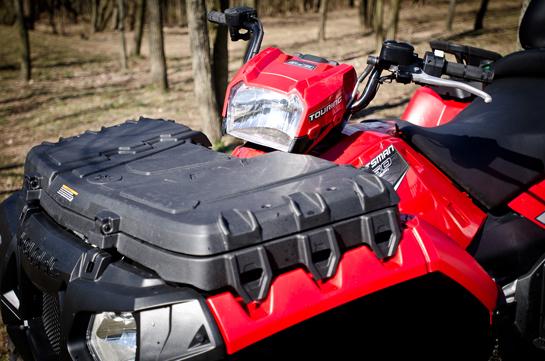
Fit and Finish
Key Features
– Painted plastic bodywork: It’s nine times more scratch resistant than standard, unpainted plastic, allowing it to hold up to abuse and still look great.
– Lock & Ride Racks: Incredibly easy to add Lock & Ride accessories without needing tools.
Performance
The Polaris plastic bodywork is not only one of the strongest and most impact resistant in the industry, but they’ve also developed a process to make the automotive-type paint adhere to the body and remain impact resistant. I was skeptical of painted plastic when it first hit the market, even after touring the facility in Minnesota and learning about the technology used to develop it. Much to my surprise, after bludgeoning the painted body with mud, briars, tree limb impacts, and flying debris, it looked great. It will take a really hard hit or scrape from a rock to do serious damage.
The Polaris Lock & Ride rack system provides a safe and secure method of mounting accessories to, or in place of, the standard rack. Our Touring 850HO comes standard with a Lock & Ride front storage box. I submerged the box several times and it successfully kept the contents clean and dry. Removing the box takes less than thirty seconds and requires no tools.
Hits
– Painted plastic bodywork has automotive quality looks with off-road durability.
– Removable Lock & Ride storage box is sleek and adds more hauling capability.
Misses
– $500 premium for a Special Edition model that adds a different colored paint and decals seems steep.
– Since Lock & Ride racks are plastic, cranking cargo down too tightly may crack the plastic.
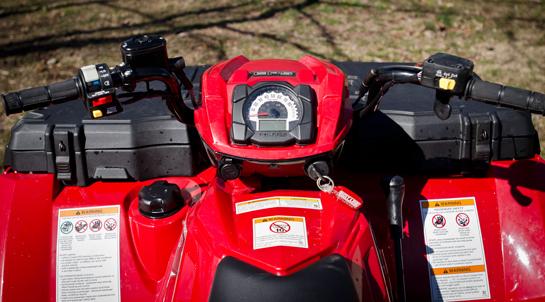
Engineering/Functionality:
Key Features
– Comfort Ride Seat Suspension: the under-seat shock absorber makes passenger comfort unrivaled, with an inch of suspension travel from the seat alone.
– Handle/Bottle holders: integrated into the Lock & Ride racks are passenger handles that double as water bottle holders.
– Pod mounted light: A separately switched 50 watt light that moves with the bars, allowing the terrain to be lighted in the direction the bars are pointed.
Performance
The Comfort Ride Seat Suspension™ on the Sportsman Touring, with its integrated under-seat shock absorber, adds an inch of travel to an already impressive rear travel of 10.25 inches. That seat is also mounted “stadium-style,” giving the passenger and unobstructed view of the trail. The rear passenger also gets elevated floorboards that compensate for the added height of the rear seat. Removable handles attached to the rear rack that also double as water bottle slings give the passenger a firm place to grip.
The separate headlight pod mounted to the handlebar is a nice touch. I was able to light a gnarly section of the trail in the direction I wanted to go rather than in the direction the nose of the ATV was pointed. This is a great way to avoid an obstacle that could have gone unnoticed had the lights only pointed forward.
_
Hits_
– Suspension passenger seat is very comfortable and provides an unimpeded view of the trail.
– A separate bar mounted headlight is an inexpensive way to provide added safety for night riding.
MISSES
– If the strap on the Comfort Ride Seat gets hidden in muck, removing the seat becomes challenging.
Final Thoughts
The 2-Up market has a devoted following and owners of these machines relish in their ability to haul an extraordinary amount of gear along with an extra passenger. Just like the touring bike crowds that love to ride their high-dollar motorcycles with a passenger to destinations around the country, the Sportsman Touring 850 H.O. delivers a similar type of adventure for the off-road crowd. If leaving that special someone alone long enough to enjoy a ride alone with your buddies is more than you can bear, or if taking this “special someone” along is the only way you’re permitted to leave the house, then the 2012 Polaris Sportsman Touring 850 H.O. should be on your short list of 2-Up adventure machines worthy of consideration.
Specifications
Engine
Type: 850 cc, 4-stroke SOHC, liquid-cooled, twin cylinder
Fuel System: Electronic Fuel Injection
Transmission: Automatic PVT with park/reverse/neutral/low/high with Engine Braking System (EBS) and Active Descent Control (ADC)
Drive Train: On-Demand True AWD/2WD
Suspension
Front Suspension Type/Shocks: Duel A-arm
Front Suspension Travel: 9 in (229 mm)
Rear Suspension Type/Shocks: Dual A-arm
Rear Suspension Travel: 10.25 in (260 mm)
Brakes: Single Lever four-wheel hydraulic disc with hydraulic foot brake
Tires/Front: 26 x 8 x 14 in Maxxis M9805
Tires/Rear: 26 x 10 x 14 in Maxxis M9806
Wheels: 14″ Cast-aluminum
_
Dimensions_
L x W x H (in): 86.5 x 47.6 x 58.25 in
L x W x H (mm): 219.7 x 120.9 x 147.9cm
Wheelbase: 57 in (144.8 cm)
Seat Height: 35.75 in (90.8 cm)
Ground Clearance: 11.25 in (28.5 cm)
Dry Weight: 798 lb (362 kg)
Capacities
Towing Capacity: 1,500 lb (680.4 kg)
Front Rack Capacity: 120 lb (55 kg)
Rear Rack Capacity: 240 lb (110 kg)
Rear storage: 5.7 US gal (21.4L)
Fuel Capacity: 5.25 gal (19.9L)
Features
Instrumentation: Analog Speedometer, Digital Odometer, Tachometer, Two Tripmeters, Hour Meter, Clock, Service Indicator, Diagnostic Indicator, Gear Indicator, Fuel Gauge, AWD Indicator, Hi-Temp/Low-Batt Lights, DC
Cargo System: Lock & Ride
Lighting: Triple 50w High Beam, Dual 50w Low Beam Headlights; Dual Brakelights/TaillightsDC
Electronic Power Steering: Standard
Colors: Boardwalk Blue, Solar Red, Pearl White Limited Edition
MSRP: $10,999
Warranty: 1 year limited factory warranty
